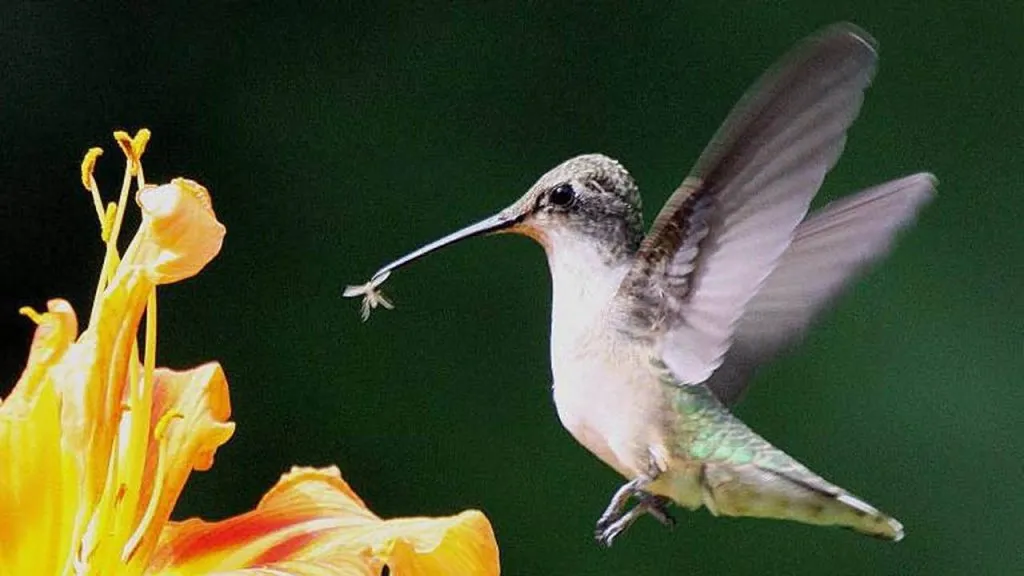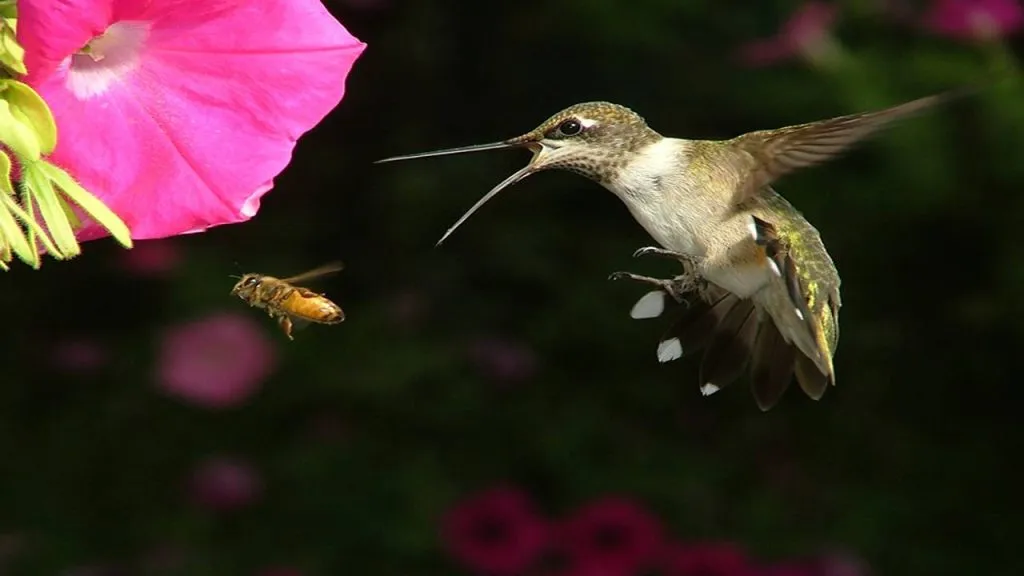As an Amazon Associate I earn from qualifying purchases.
Hummingbirds captivate us with their stunning colors, incredible agility, and love for sweet nectar.
While we’re familiar with their affection for flower nectar, many wonder if they also feast on insects.
In this article, we’re going to explore what insects hummingbirds like to eat.
We’ll also talk about whether baby hummingbirds eat insects, share tips on how to feed hummingbirds and delve into their eating habits, including how often they eat and how much they consume.
So, let’s begin and learn more!
Do Hummingbirds Eat Insects?

Yes, hummingbirds do consume insects. While they mainly feed on nectar from flowers, they also snack on small bugs.
Besides nectar, hummingbirds get a lot of their water from the insects they munch on.
Insects are important because they give hummingbirds the protein and nutrients they need to stay healthy and alive.
Hummingbirds rely on insects a lot, especially when they’re taking care of their babies or during migration and breeding seasons when they need more energy.
Hummingbirds can gobble up anywhere from just a few dozen to several hundred insects every day.
They eat all sorts of insects, from tiny ones like mites, aphids, and thrips to bigger ones like beetles and caterpillars.
This diverse diet ensures they receive the necessary nutrients for their well-being.
However, here’s a list of insects that hummingbirds eat:
- Gnats
- Aphids
- Mosquitoes
- Fruit flies
- Midges
- Small flies
- Even tiny spiders
It’s worth noting that the specific types of insects consumed may vary depending on factors such as geographic location, habitat, and the preferences of each hummingbird species.
This highlights the dynamic nature of their diet and their ability to adapt to the available resources.
Do Baby Hummingbirds Eat Insects
“Yes, baby hummingbirds do consume insects as part of their diet.
During the early stages of their development, hatchlings rely on a diet rich in protein, which is crucial for their rapid growth and maturation.
Insects provide essential nutrients necessary for their health and development, helping to strengthen their bodies and prepare them for fledging.
Parent hummingbirds diligently seek out insects to feed their young, ensuring they receive the necessary nutrition for optimal growth.
This insect-rich diet helps to support the energetic demands of the rapidly growing chicks, enabling them to reach maturity successfully.
So, yes, baby hummingbirds do eat insects as they require the protein and nutrients provided by insects for their healthy development
A Guide on Feeding Hummingbirds: Insects & Protein
1. Selecting the Ideal Hummingbird Feeder
When choosing a feeder, make sure it’s tailored for hummingbirds, featuring small feeding ports that suit their lengthy, slender bills.
Opt for feeders sporting vibrant hues like red or orange, as these colors are particularly appealing to hummingbirds.
Think about the feeder’s size and material; glass or plastic feeders are both convenient choices, as they’re simple to clean and upkeep.
2. Creating Your Own Hummingbird Nectar
Make a straightforward nectar mix by combining one part white granulated sugar with four parts water. It’s best to steer clear of honey, artificial sweeteners, or red dye.
Heat the water until the sugar is completely dissolved, then allow it to cool down before pouring it into the feeder.
Any leftover nectar can be stored in the fridge for up to a week.
3. Optimal Feeder Positioning
Hang your feeders in shaded spots to slow down nectar spoilage caused by direct sunlight.
Keep feeders clear of windows and shiny surfaces to lower the chance of bird collisions.
Position feeders where they’re convenient for you to reach and refill, and at a height that allows for easy observation.
4. Keeping Your Feeders Clean and Safe
Regularly wash feeders with hot water and mild soap, using a bottlebrush to thoroughly clean all areas and prevent mold and bacteria buildup.
After washing, rinse the feeders well and let them air dry completely before refilling them with fresh nectar.
Check feeders for any signs of damage or wear, and replace any broken parts to maintain the safety of hummingbirds.
5. Expanding Food Options
Add a mix of nectar-filled flowers like trumpet vine, bee balm, and salvia to your garden to offer extra nourishment for hummingbirds.
Incorporate native plants to attract various insects, which are a crucial protein source for hummingbirds.
Steer clear of pesticides and herbicides that could harm both hummingbirds and their food supply.
6. Adapting to the Seasons
If you live in areas where hummingbirds stay or pass through during winter, keep your feeders out all year.
In hot weather, change the nectar more often to avoid it fermenting or spoiling.
Keep an eye on hummingbird behavior and adjust how often you refill the feeders to match their needs as the seasons change.
How Often & How Much do Hummingbirds Eat?
Hummingbirds eat a lot and often because they have fast metabolisms. On average, they eat about half of their body weight in food every day.
For example, if a hummingbird weighs 3 grams, it might eat around 1.5 grams of food daily.
They feed many times each hour, especially when it’s sunny and bright outside. They might stop by feeders or flowers every 10 to 15 minutes during the day to get more energy.
When they’re busy breeding, nesting, or flying long distances during migration, hummingbirds need even more food to keep up their energy.
So it’s important to always have food available, like nectar in feeders or flowers, to help them stay healthy and strong throughout the day.
How Do Hummingbirds Hunt?

Hummingbirds are good at finding and catching food. They have excellent eyesight, so they can spot prey while flying around.
When they see something tasty, like a bug, they quickly dive down and grab it with their long, thin beaks.
Hummingbirds eat all sorts of small insects, such as moths, mosquitoes, flies, and ants. They also munch on lots of tiny spiders and other creepy crawlies.
Besides bugs, hummingbirds also drink nectar from flowers and sap from trees. Nectar gives them energy, while sap gives them important nutrients and moisture.
To drink nectar, hummingbirds use their long tongues to slurp it up from inside flowers. They stick their tongues into the flower and then curl them back into their mouths to get the nectar.
Sometimes, they use their beaks to poke holes in tree bark to get to the sap inside. Hummingbirds need to eat often to keep their energy up.
They might chow down every 10 to 15 minutes throughout the day.
During busy times, like when they’re breeding or migrating, they might eat up to 8 times their body weight in food every day!
Conclusion
In conclusion, although nectar gives hummingbirds energy, they also need insects for protein.
Knowing what they eat helps us appreciate these flying wonders and helps us make habitats that are good for them.
So, when you see a hummingbird’s colorful beauty, remember they need both nectar and insects to fly high and stay healthy.
FAQ’s:
The most common predators of hummingbirds are larger birds of prey like hawks and falcons, as well as domestic cats.
These predators often target hummingbirds when they’re perched or flying near feeders.
The best thing to feed hummingbirds is a nectar solution made from sugar and water.
Mix one part sugar with four parts water, and avoid using honey or artificial sweeteners.
Additionally, offering protein-rich foods like small insects or fruit flies can supplement their diet and provide essential nutrients.
The Ruby-Throated Hummingbird is known to be one of the most aggressive hummingbird species.
They fiercely defend their territory and food sources from other hummingbirds, often engaging in aerial battles to establish dominance.
Hummingbirds are attracted to brightly colored, tubular-shaped flowers with plenty of nectar.
Some popular flower choices for attracting hummingbirds include trumpet vines, bee balm, salvia, and red cardinal flowers.
Planting a variety of nectar-rich flowers in your garden can help attract hummingbirds and provide them with a diverse food source.
Amazon and the Amazon logo are trademarks of Amazon.com, Inc, or its affiliates.

